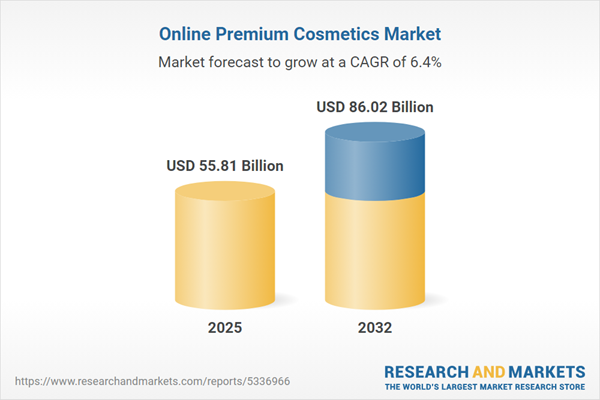Speak directly to the analyst to clarify any post sales queries you may have.
The online premium cosmetics market is evolving rapidly as digital transformation and shifting consumer priorities reshape industry benchmarks. Senior executives face new opportunities and pressures as brands compete to deliver authenticity, personalization, and sustainability in a rapidly digitizing space.
Market Snapshot: Online Premium Cosmetics Market Overview
The Online Premium Cosmetics Market grew from USD 52.52 billion in 2024 to USD 55.81 billion in 2025. It is expected to continue expanding at a compound annual growth rate (CAGR) of 6.36%, reaching USD 86.02 billion by 2032.
This growth underscores rising digital adoption, new consumption habits, and the lasting value placed on innovation, ethical sourcing, and tailored consumer experiences. Strategic stakeholders benefit from understanding nuanced shifts and region-specific dynamics driving premium beauty sales online.
Scope & Segmentation of the Online Premium Cosmetics Market
- Product Category: Bath & Body, including body lotions and shower gels; Fragrances for men and women; Hair Care products such as conditioners, shampoos, and styling products; Makeup comprising eyeshadow, foundation, lipstick, mascara; Skincare featuring facial cleansers, masks, moisturizers, serums.
- Gender: Female and male consumers with unique beauty and grooming preferences.
- Distribution Channel: Direct to consumer platforms, online marketplaces, online retailers, and subscription services enabling digital engagement and tailored product curation.
- Skin Concern: Acne treatment, anti-aging, brightening, hydration, and sensitivity relief solutions.
- Geographic Regions: Americas (including North America and Latin America), Europe, Middle East & Africa, and Asia-Pacific, with coverage down to sub-regional country levels.
- Market Players: Significant companies analyzed include The Estée Lauder Companies Inc., Shiseido Company, L'Oréal S.A., Chanel S.A., LVMH, Beiersdorf AG, Amorepacific, KOSÉ, Coty Inc., and Clarins S.A.S.
Key Takeaways for Strategic Decision-Makers
- Premium cosmetics brands are prioritizing technology-driven personalization, delivering virtual try-on tools and AI-based diagnostics that reshape the luxury purchase journey.
- Ethical transparency and sustainable packaging are influencing consumer choices, compelling brands to innovate across clean formulations and eco-conscious practices.
- Authentic brand storytelling, enhanced by influencer partnerships and social media storefronts, is now critical in building engagement and brand equity online.
- Agile supply chains are necessary as limited-edition releases, on-demand production, and subscription models accelerate the pace of innovation and boost direct consumer relationships.
- Region-specific consumer behaviors require nuanced digital marketing and channel strategies, particularly in markets driven by social commerce, local regulations, and cultural preferences.
Tariff Impact on Supply Chain and Pricing
United States tariffs implemented in 2025 have impacted supply chain strategies and price structures across the premium cosmetics sector. Brands are balancing the need to absorb increased input costs with maintaining pricing power, while exploring nearshoring and local sourcing to reduce tariff exposure. Partnerships with domestic suppliers and artisans are boosting resilience and aligning with consumer demand for ethical and sustainable sourcing.
Methodology & Data Sources
This report integrates secondary research from company disclosures, regulatory filings, and industry publications with primary insights from executive and sector expert interviews. An online consumer survey and real-time analytics further inform the analysis. Quality control steps such as peer review and triangulation ensure actionable, validated outcomes.
Why This Report Matters
- Helps executives understand emerging trends and strategic imperatives in the online premium cosmetics market for investment and resource planning.
- Enables informed, data-driven decisions by presenting a clear view of segmentation, regional dynamics, and consumer priorities shaping the market’s future.
- Delivers actionable recommendations for digital transformation, supply chain agility, and sustainability—core priorities for maintaining competitive advantage.
Conclusion: Positioning for Growth in Online Premium Cosmetics
Leading organizations in the online premium cosmetics sector gain from robust digital integration, strong sustainability alignment, and tailored market strategies. This report equips stakeholders to navigate complexity and confidently pursue growth.
Additional Product Information:
- Purchase of this report includes 1 year online access with quarterly updates.
- This report can be updated on request. Please contact our Customer Experience team using the Ask a Question widget on our website.
Table of Contents
3. Executive Summary
4. Market Overview
7. Cumulative Impact of Artificial Intelligence 2025
Companies Mentioned
The companies profiled in this Online Premium Cosmetics market report include:- The Estée Lauder Companies Inc.
- Shiseido Company, Limited
- L'Oréal S.A.
- Chanel S.A.
- LVMH Moët Hennessy Louis Vuitton SE
- Beiersdorf AG
- Amorepacific Corporation
- KOSÉ Corporation
- Coty Inc.
- Clarins S.A.S
Table Information
| Report Attribute | Details |
|---|---|
| No. of Pages | 187 |
| Published | October 2025 |
| Forecast Period | 2025 - 2032 |
| Estimated Market Value ( USD | $ 55.81 Billion |
| Forecasted Market Value ( USD | $ 86.02 Billion |
| Compound Annual Growth Rate | 6.3% |
| Regions Covered | Global |
| No. of Companies Mentioned | 11 |









